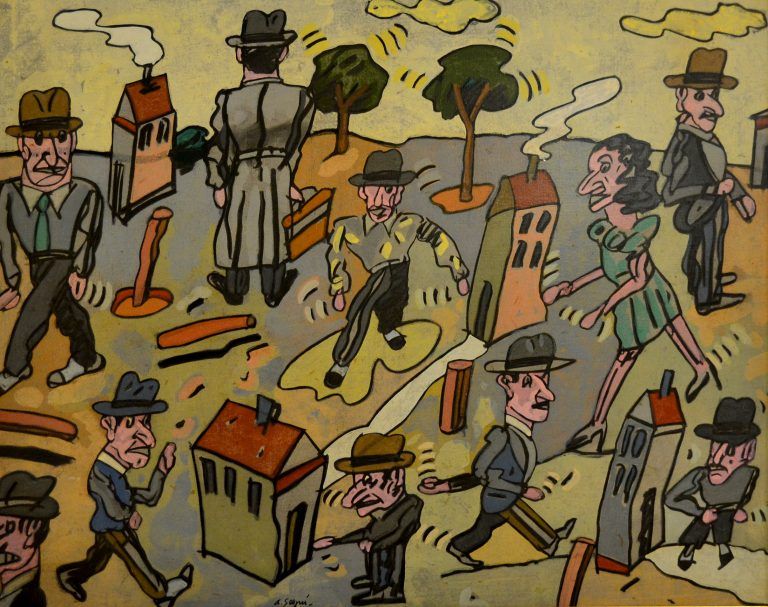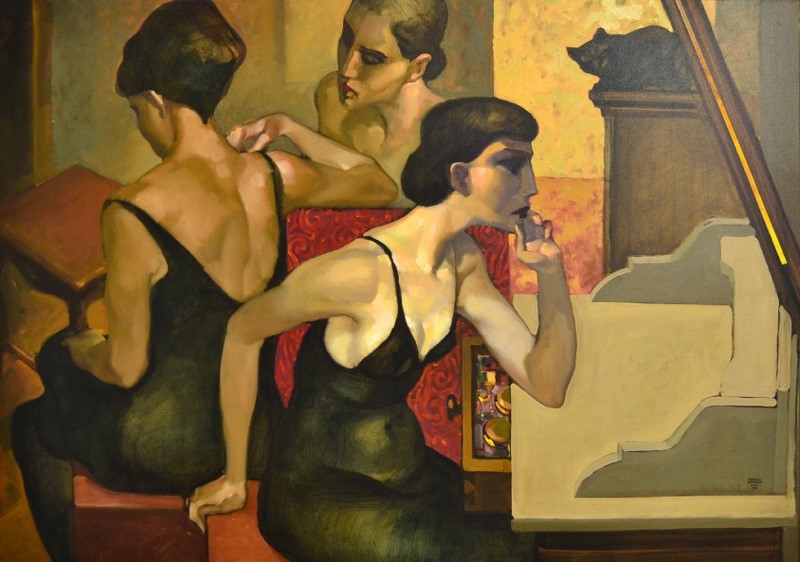Parallel to the informalist and abstract artistic movements that flooded the currents of mid-twentieth century international art, a type of art arose in Latin America at the end of the 1950s which was also determined to break with tradition, whilst defending the prevalence of figuration. Based on appropriation and the reinterpretation of avant-garde languages, new languages were created that respond to both their need for experimentation and communication.
In Latin America there was no equivalent to the movements that occurred in the other continents, at least not in terms of content; we can, however, speak about direct influences. Informalism, abstract expressionism, kinetic art, etc.; for Latin American artists all of these represent a reinterpretation of languages and the adaptation of form and content to their social and cultural reality to create a new art. In this room we will see those currents that carried all these influences to the terrain of contemporary figuration.
The selection of works and artists, with different techniques, supports and aesthetic approaches, encompasses movements, such as the Nueva Figuración (New Figuration), and proposals from individual artists alike. They are all related to each other, either by their theme, aesthetic theories, or influences.
-
 Figures, 1985
Figures, 1985Antonio Seguí
Ralli Collection © Antonio Seguí, VEGAP, Málaga, 2025
Oil on canvas
90 x 70 cm -
 Caronte, 1985
Caronte, 1985Ernesto Deira
Ralli Collection
Acrylic on wood
200 x 160 -
 The dream, 1969
The dream, 1969Rómulo Macció
Ralli Collection
Acrylic on canvas
130 x 140 cm -
 Linguagem no espelho, 1988
Linguagem no espelho, 1988Juarez Machado
Ralli Collection
Oil on canvas
132 x 97 cm
We will now look at some of the most interesting currents that fall under the umbrella of contemporary figurative artists, differentiated according to the way they work.
In contemporary Latin American art, the pre-Columbian and colonial legacy are present in equal measure, both forming part of the complex task of defining and representing Latin American identity. Speaking of realism or reality for Latin American artists is to speak about these complex social, historic and individual systems. Nevertheless, in this context we should not understand “realism” as truthfulness. Artists perform a reinterpretation of reality, analysing it through the filter of social criticism and the linguistic keys of contemporary art.
The artist Herman Braun-Vega (Peru, 1933 – France, 2019), classified as a “hyperrealist”, uses a naturalist language with references to traditional painting, which in turn shares allusions to avant-garde art and great masters of traditional Spanish art, appropriating both languages and direct references to them. In his works, he precisely represents the reality of artistic and cultural miscegenation that takes place in Latin American countries, particularly in reference to his native Peru.
We see this same use of appropriation from the Argentine Eduardo Labombarda (1949) in his work “El federal”.
Using symbols and references that could be deciphered by the public as a starting point, this group of Latin American artists revealed their concerns about the socio-political and cultural situations of their times.
Another of the artists who we can place within this symbolic realism and who we see in this room is Carmen Aldunate (Chile, 1940). Clearly influenced by 15th-century Flemish painting, in her work Aldunate combines great technical skill with a narrative rich in psychological and symbolic content. The human figure, especially female, is the protagonist in her work, which we can classify as part of the neo-figurative movement, linked to magical realism due to the way she deals with the imaginary and the naturalistic aura she achieves in her pieces.
Aldunate’s work, with an amiable presence but critical content, uses sarcasm and humour to denounce the oppression of the female gender which has suffered for centuries and continues to do so.
Informalism in Latin America does not conform to the guidelines it follows in North America and Europe either. Although it is true that there are movements in which material experimentation predominates, with gestural and abstract painting in Latin America (such as Arte Madí, concrete-invention art, etc.), the aspect of reinterpreted informalism that emerges on the same continent is striking. This “informalism” (for want of a better term) is also based on the use of colour and marks, but without ever completely losing the reference to the motif. These works focus on the human figure, represented with an existential background that speaks to us of the philosophical concerns of humans.
The great paradigm of this aspect and the alternative to abstract and informalist art is represented by the Nueva Figuración Argentina (New Argentine Figuration). This movement proposes a revaluation of the human figure through the use of expressionist realism and an intense, flat palette. This aesthetic, based on the grotesque, imbalance, and disharmony, aims to reflect the prevailing social and political chaos.
Within this current we find the Argentines Ernesto Deira (1928-1986) and Rómulo Macció (1931-2016), founding members of the now-defunct group La Otra Figuración (The Other Figuration) along with Luis Felipe Noé (1933) and Jorge de la Vega (1930-1971), and representatives of the Nueva Figuración Argentina.
In Ernesto Deira’s works we see an emphasis on imbalance and aggressiveness, with an expressionist use of colour which is nevertheless the result of a very thoughtful composition.
Rómulo Macció produces more amiable works, especially after the end of La Otra Figuración, although in them contrasts of colours, marks and expressionist brushstrokes prevail, leaving the material of the painting more exposed.
Antonio Seguí (Argentina, 1934) and Carlos Alonso (Argentina, 1929), also involved with La Otra Figuración although never officially part of it, do fit within La Nueva Figuración. They both produced figurative and narrative works, with a synthetic realism in which the anecdotal is disregarded to emphasise the subject of their work: representations of human figures with a lot of content focusing on social criticism.
Another case is that of Raquel Forner (Argentina, 1902 – 1988), who belonged to the Paris Group and the Florida Group. With cubist and expressionist beginnings, her work stands out for the use of figuration and the symbolism of her images, which also bring her closer to surrealism. The world’s biggest historical and political events are marked in her work. Starting in 1957, Forner’s work came closer to the concepts of form and matter explored by the Argentine New Figuration. We can clearly see a use of this language in works from her space series.
One example of this is the work by the Cuban Cundo Bermúdez.
Related artists
RELATED WORKS
ACTIVITIES AGENDA
RELATED PROGRAMS
Related content



